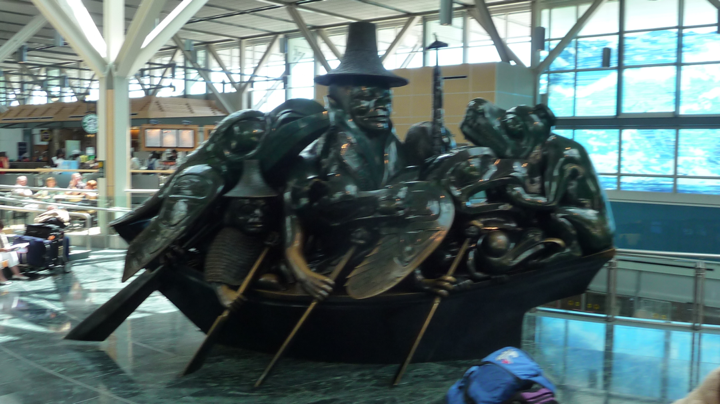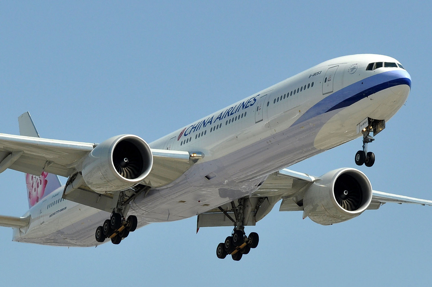Las Vegas - LAS
/Locals flying to Asia have hit the jackpot; for connections it's snake eyes
Las Vegas has become a global destination for entertainment and gambling, and while there is a small pan-Asian "Chinatown" about 2 miles west of the Strip, the primary reason you'll see a prominent and growing Asian influence in design, dining, and performances is because of high-income travelers from East Asia.
Well over a half-million travelers from Japan, Korea, and China visit Las Vegas each year - China alone sends over 200,000 - and international visitors spend 73% more per person than domestic guests, per the city's convention authority. So the city and its casino complexes are putting down a lot of chips to cater to these high rollers...
Of course, every airplane landing has a takeoff too, and that means growing outbound Transpacific flying opportunities for residents of the Desert Southwest.
While most trips to Asia from Las Vegas presently involve a connection at a West Coast hub like Seattle, San Francisco, or Los Angeles, new-generation aircraft and more-liberal US travel visa rules are spurring direct flights:
Currently, Korean Air flies nonstop to Seoul-Incheon 4 times per week with their Boeing 777-300, and from that impressive hub a great deal of China, Japan, and Southeast Asia can be reached with just one connection.
Hainan Airlines has received authority to begin nonstop service to Beijing with a 3-per-week schedule with 787 Dreamliner equipment, starting in December 2016.
The city is courting carriers from all sides of the Pacific Rim, so we should expect even more nonstop service within the next few years.
Customs Arrival
The historic Terminal 1 building at McCarran International was simply never designed to handle jumbo jets or any serious crowds needing Customs services. The airport limped along for years with a makeshift Terminal 2 just north of Terminal 1, but it took until 2012 for a world-class international facility to get built. (Terminal 2 was immediately closed, and finally torn down in 2016.)
All international arrivals that require Customs clearance now happen at the E-concourse gates attached to Terminal 3. After exiting the aircraft, follow the enclosed walkway down to ground level for passport control, baggage claim, and Customs declarations. Time to clear Customs averages 15-30 minutes and seldom exceeds an hour. Exiting the arrivals facility sends travelers past the domestic baggage-claim belts and then out into the massive main ground-floor arrivals hall.
Local residents (or anyone from farther out who drove to LAS) will find the Terminal 3 parking lot directly across the ground-level access drive. Taxicabs and shuttle buses also are right there.
People who are connecting to another flight will have their bags with them, and will need to check in with their onward airline, since Korean Air is not directly connecting with any other carrier at LAS, and there aren't bag re-check counters in the arrivals facility.
While that sounds straightforward, it all depends on what carrier you are using - an inter-terminal connection may be necessary, and if so, you'll need to carry your bags with you on the shuttle bus to Terminal 1. Passengers flying out on Alaska - Virgin America, United, JetBlue, Sun Country, Hawaiian, or Frontier can simply go upstairs in Terminal 3 to the check-in counters. Passengers taking American, Delta, Southwest, Allegiant, or Spirit will have to take the bus to Terminal 1.
Navigating the Airport
The map above only begins to show how confusing McCarran's layout is. Terminal 1 has been added onto countless times, leaving no clear sightlines for a traveler to follow either outbound or inbound. Pickup and drop-off roadways run on both sides of the building, and it is not obvious where to catch the shuttle from Terminal 1 to Terminal 3 (it's under the parking ramp). Likewise, there are two security screening areas in Terminal 1, but travelers only see the one for Allegiant and Spirit gates when they ascend from the ticketing area.
From Terminal 1, passengers on Spirit and Allegiant use the A and B gates; flyers taking Southwest use the C gates, and people using Delta and American trek out to the D gates.
Terminal 3 is - in contrast - a logically laid-out building with a clear flow from the roadway to the ticket counters to security and then out to the aircraft gates. The E gates for Alaska - Virgin America and JetBlue (as well as Korean Air) are immediately through security. The tram stop is also right through security and down - that train runs to the D gates for United, Frontier, Hawaiian, and Sun Country passengers.
It is actually possible to use the trams to stay in the secure zone and travel from the E gates, to the D gates, and then over to the C, B, and A gates (and the other way around). But in the case of a connection to a Korean Air flight, that would only make sense if the traveler only had a carry-on bag. In reality, only aviation enthusiasts with plenty of time before a flight would ever bother.
For a traveler with checked bags trying to connect to the Korean Air flight, that person would need to retrieve their luggage, take the shuttle to Terminal 3 (unless they arrived at T3), go to the Korean Air check-in desk to drop their bags, and then go through security again to get to their gate.
The A, B, and C gate areas and walkways are undeniably crowded (Allegiant, Spirit, and Southwest) and get uncomfortably warm from both the mass of people as well as the desert sun pouring through the windows - the D and E gates have much more space both for seating and also in the hallways, and were designed to bring natural light in but not direct sunlight, so they're better air-conditioned.
Family-friendly amenities and hidden gems
LAS has well-curated history museum exhibits pre-security in the Esplanade area of Terminal 1, post-security in the connector bridge from the Esplanade out to the C gates, and in the central hub of the D gates. They tell the stories of the people who built the airport operation and managed the carriers who used it, the glamour and celebrity associated with the place, wartime service, and the many colorful aircraft which flew through. Plenty to read, many historic artifacts, and even exhibits that kids would enjoy.
Artwork abounds in both terminals and in all the gate areas; some is conceptual but there is much to delight children, like the super-sized sculptures of desert animals in the core areas of the D gates. Massive - and massively fun - triptych paintings of Las Vegas' celebrities and folklore wrap around the gates at the outer ends of the D gates.
A big airport-themed play area has been set up in the central hub of the D gates, just above the tram stops and behind the food court. Full-height windows and a telescope look over the ramp, steps and slides are available to work off energy, and there's seating for families to rest.
Excellent views of the Strip and its attractions can be had from many vantage points, and the mountains offer an ever-changing backdrop as the sun paints them. Flights from Central America and Europe are frequent so there's a constant parade of aircraft in unique color schemes - and you'll also likely see a stream of executive aircraft ranging from small jets all the way up to private 747s. Also look for the white 737s with the big red stripe: those work for a high-security operation called JANET and are used to shuttle staff back and forth to the secret Area 51!
Restrooms
Clean and functional, with adequate lighting but no place to set bags down except the floor or a hook on a stall door. Stalls are a bit tight and not long enough to manage yourself and a child. "Companion Care" restrooms, however, are available throughout the complex, and these are amply-sized for taking care of several children.
Food and Shopping
The A and B gates have only the bare minimum of retail (basically Hudson News and vending machines), but there are a reasonable number of coffee shops and fast-casual dining options. A greater variety of shops open up once you get into the C gates, plus a proper food court at the very end of the C concourse including restaurant-style dining.
The D gates, in contrast, could be described as a shopping mall with aircraft docking all around it. Travel basics, books, candy, t-shirts and toys are all represented, but also luxury brands, cosmetics, luggage, and men's and women's fashion. The usual mix of coffee, fast-food, and sit-down restaurants is also blended through the D complex.
The E gates have a higher proportion of space devoted to duty-free shopping and high-end goods, which makes sense for all the international flights, but not as much variety for the family-travel crowd. There are two mini-food-courts on either end of the concourse. Since the D gates are so conveniently-accessible via the underground tram, it's a solid option if you have time before your overseas flight.
Connectivity
McCarran has free Wi-Fi throughout the terminal and gate areas, and the signal is strong enough to support watching video. Availability of power ports at the gate varies by airline, but there are numerous charging stations on the concourses, and also in the food courts.
As of 2016 there is still no mass-transit onto the Strip or the rest of the city, but the local council has finally begun talking about it after vehicle-traffic problems became ludicrous year-round - that still means relief is still not going to happen until the 2020s, however.




























